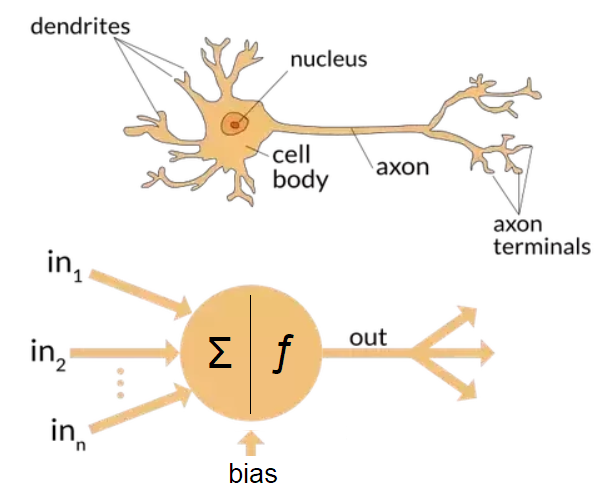Neural Networks
Introduction to Neural Networks and Deep Learning
The simplest definition of a neural network, more properly referred to as an 'artificial' neural network (ANN), is provided by the inventor of one of the first neurocomputers, Dr. Robert Hecht-Nielson. He defines a neural network as:
a computing system made up of a number of simple, highly interconnected processing elements, which process information by their dynamic state response to external inputs.
Simple Processing Element
This is a neuron.

Dynamic response
Two parts:
- , which is a weighted sum of the inputs,
For a linear model: . For a non-linear model, will apply a transformation.
Examples:
- Logistic curve
- tanh
- ReLU Activation Function
- Step Function
Neural Networks as Supervised Learners
Can be used for regression or classification
- classification: Bike, Drive
- Regression: # of km
Learning as an Optimization Problem
The model learned should MINIMIZE the error on the overall training set.
Understanding Different Errors
Context: Tourist agency would like to figure out what is the best duration for excursions.
Training: Data with a single feature: 1,6,6,2,1,6,3,6,4,6,6
Model 1: Take the most common value in dataset. Model always predict 6 as preferred time.
Model 2: Rounded Average 47/11 = 4.27 = 4. Model always predicts 4 (average time).
L1 Error
Test: new people are asked about their preferences, and this data is gathered: {2,3,6,6,3,5}.
L1 Error Basically looks at difference between predictions and sums it.
L2 Error
Now L2 Error looks at difference between predictions squared and sums and divided by half.
L(infinite) Error
Picks the max error out of all the errors
How to Minimize Error?
Greedy Algorithm: Gradient Descent
Let's evaluate the contribution of a weight on the error, and adjust that weight(up or down) to reduce the error.
, we take the derivate of the error according to the weight.
Advantage of L2:
- if gradient(derivative) is positive, bring down
- if gradient is negative, bring up
Disadvantage of L1:
- there is discontinuity at some points.
Linear Regression Learner
- gradient descent for linear regression
Gradient Descent
- Initialize weights at random
- Repeat
- For each example in the training set:
- Predict (forward pass)
- Calculate
- For each weight
- Calculate derivate of error
- Update weight
- For each example in the training set:
- Until "done"
- Fixed number of iterations
- Error < error threshold
- < change threshold
Normalization
before starting the learning, we can normalize (between -1 and 1) or between (0 and 1) each of the attributes.
Logistic Regression Learner
-> formula of sigmoid function.
This is known as a perceptron as it is a non-linear function.
Gradient Descent
- Initialize weights at random
- Repeat
- For each example in the training set:
- Predict (forward pass)
- For each weight
- Calculate derivate of error
- Update weight
- For each example in the training set:
- Until "done"
- Fixed number of iterations
- Error < error threshold
- < change threshold
Log Loss Error
To optimize the log loss error for logistic regression, minimize the negative log-likelihood.
where is the sigmoid function.
Multinomial Perceptron
Expansion to Multiple Mutually Exclusive Classes leads to a multinomial perceptron.

Linearity
Non-Linearity
Assume m classes. Instead of the sigmoid, now the output on node (class k), among the m node, is given by the softmax equation:
Error Function
The error can still be the cross-entropy, generalized to multiple classes, given by:
where is the target(0,1) and is the output.
Gradient Descent
- Initialize weights at random
- Repeat
- For each example in the training set:
- Predict (forward pass)
- For each weight
- Calculate derivate of error
- Update weight
- For each example in the training set:
- Until "done"
- Fixed number of iterations
- Error < error threshold
- < change threshold
XOR Affair

Limit to linear Separators
- there is no way to draw a single straight line so that the circles are on one of the line and the dots on the other side.
- Perceptron is unable to find a line separating even parity input patterns from odd parity input patterns.
Adding a Layer
Solution to XOR problem is to add a layer.